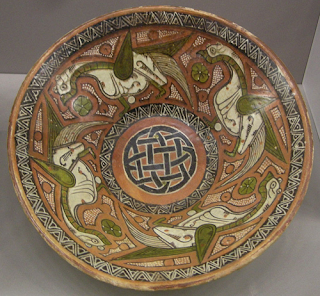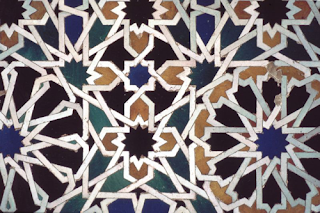 |
| 10th Century dish, EastPersia (photo by Sailko), Wikipedia |
***
This post started as a guide for drawing Celtic knots. It has expanded to knot designs and patterns in various cultures and some intriguing information about the use of needles by Neanderthals 50,000 to 100,000 years ago.First, the Celtic knots. Some call it plaiting, a term usually applied to braiding hair. This little example is shown on the blog Celtic Sprite.
***
 |
| CelticKnotwork: TheUltimateTutorial, Branawen |
***
There are many tutorials online for Celtic and other patterns, such as Making Celtic Knots (dots method); How to draw Celtic knots; and How to design Celtic Knot Patterns by Creative Doodling. For a general discussion of patterns in art, take a look at Quick Tips in Art & Design: Pattern.
Celtic knots are not just Celtic, many cultures use interlaced patterns in their artwork, especially the Islamic. And there is Chinese knotting, which can be duplicated in macramé. Here's a sample Islamic pattern.
***
 |
| Pattern in Islamic Art, Wade Photo Archive |
***
Knowing that these repeat patterns cross cultures, I tried to find an article that discusses this. Instead I found that man's use of needles goes back 100,000 years:
Archaeological studies indicate that the art of tying knots dates back to prehistoric times. Recent discoveries include 100,000-year old bone needles used for sewing and bodkins, which were used to untie knots. (Wikipedia)
Further, Neanderthals may have taught modern humans how to make needles:
Bone tools have been discovered in the context of Neanderthal groups as well as throughout the development of modern humans. Archaeologists have long believed that Neanderthals learned how to make bone tools from modern humans and by mimicking stone tools, viewing bone as simply another raw material. Modern humans, on the other hand, took advantage of the properties of bone and worked them into specific shapes and tools.
A recent discovery of specialized bone tools at two Neanderthal sites in southwestern France brings to light the idea that Neanderthals may have actually taught modern humans how to make specialized bone tools. The uncovering of lissoirs (“polishing stones”) at these sites is significant as they are about 51,000 years old, predating the known arrival of modern humans to Europe. (Wikipedia: Bone Tool)
In researching this topic I stumbled across World Myths in Legend & Art. Worth exploring.
-- Marge

No comments:
Post a Comment